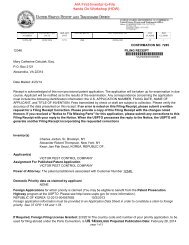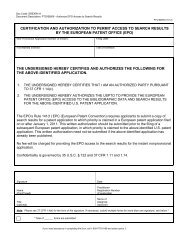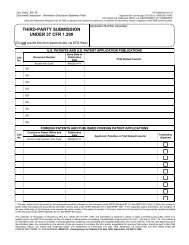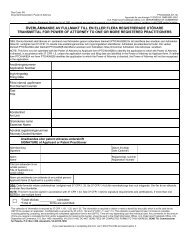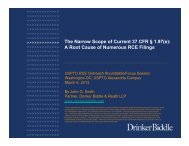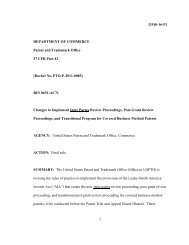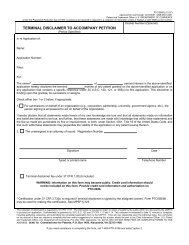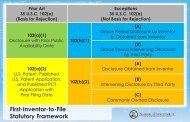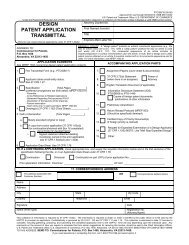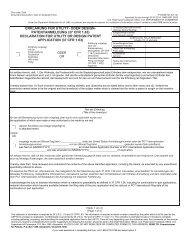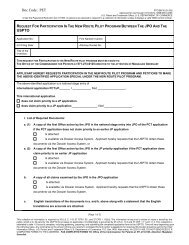ACC and IP Committee Letter regarding IPR and PGR
ACC and IP Committee Letter regarding IPR and PGR
ACC and IP Committee Letter regarding IPR and PGR
Create successful ePaper yourself
Turn your PDF publications into a flip-book with our unique Google optimized e-Paper software.
created therefrom, places the submitting party <strong>and</strong> practitioner in a conundrum when attemptingto articulate its relevance to the proceedings. The opposing party will, in turn, aggressivelyanalyze the written description <strong>and</strong> seek to develop arguments that the submitting partymisrepresented the submission, inevitably resulting in a rash of new inequitable conduct <strong>and</strong>/ormisconduct allegations.In addition, conflicts will arise with respect to a party’s subjective determination that apiece of information is not inconsistent with a previous position it has taken (<strong>and</strong> thus notdisclosed in the first place)—the mere failure to disclose the information will be heavilyscrutinized by third parties <strong>and</strong> asserted as a basis for inequitable conduct or misconduct. SeeTherasense, Inc. v. Becton, Dickinson <strong>and</strong> Co., 649 F.3d 1276, 1290 (Fed. Cir. 2011) (En BancFederal Circuit attempting to cure the “plague” of inequitable conduct pleadings by raising thest<strong>and</strong>ard to “clear <strong>and</strong> convincing evidence that the applicant knew of the reference, knew that itwas material, <strong>and</strong> made a deliberate decision to withhold it.”).The Rule 1.56 duty of c<strong>and</strong>or described above attaches to all parties associated with theprosecution of a matter before the PTO. This will include in-house counsel responsible formanaging <strong>IP</strong>R <strong>and</strong> <strong>PGR</strong> proceedings. Thus, the tension between the duty to the PTO <strong>and</strong> theduty zealously to advocate for one’s client is a significant concern for corporate counsel.Furthermore, the proposed rule projects a heavy cost burden on the submitting party inlocating, evaluating <strong>and</strong> describing the information. Similarly, the party receiving theinformation will incur costs from evaluating the information for evidence of bad faith on the partof the submitting party. These burdens detract from the cost predictability of the trials <strong>and</strong> willdeter companies from utilizing these proceedings.C. The PTO Should Revise Rule § 42.51(b)(3) to Eliminate the SubmittingParty’s Ethical Concerns <strong>and</strong> to Control Costs.The requirement for a written description of the information goes too far in requiring thePetitioner <strong>and</strong> patent owner to argue against their own interests, <strong>and</strong> requires the submitting partyto make interpretations <strong>and</strong> offer explanations that will result in a new line of inequitableconduct <strong>and</strong> misconduct inquiries relating thereto. The proposed rule should be changed toeliminate the requirement for a written description. Consistent with current practice under Rule1.56, the parties should be required to disclose information material to patentability withoutrequiring the submitting party to describe the information. Moreover, consistent with Rule1.97(h), disclosure of the information should not be construed as an admission that theinformation is, in fact, material to patentability. The opposing party will receive the submission<strong>and</strong> will have an opportunity—<strong>and</strong> is in fact in the best position—to evaluate the party’ssubmission <strong>and</strong> advance applicable arguments <strong>regarding</strong> prior inconsistent positions.The proposed change will eliminate the conflict that all participants will face whenevaluating information <strong>and</strong> considering how to characterize that information in a submission tothe PTO. The change will also reduce each party’s costs by eliminating the requirement for thesubmitting party to provide a written explanation of the information, <strong>and</strong> by eliminating “badfaith” or inequitable conduct claims <strong>regarding</strong> mischaracterization of the information. The6


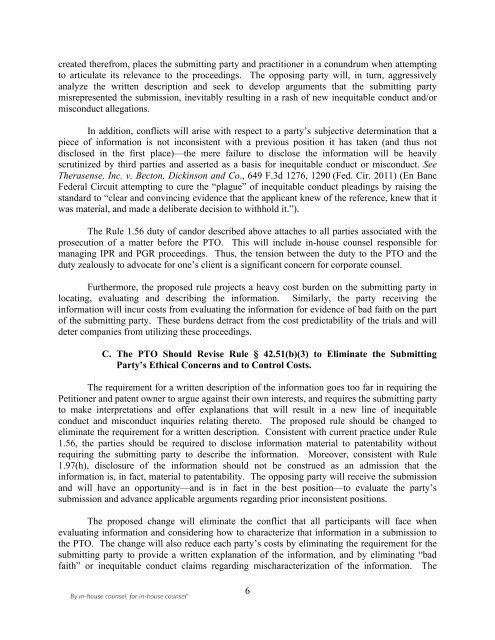
![Printable version [PDF] - United States Patent and Trademark Office](https://img.yumpu.com/51835259/1/184x260/printable-version-pdf-united-states-patent-and-trademark-office.jpg?quality=85)
